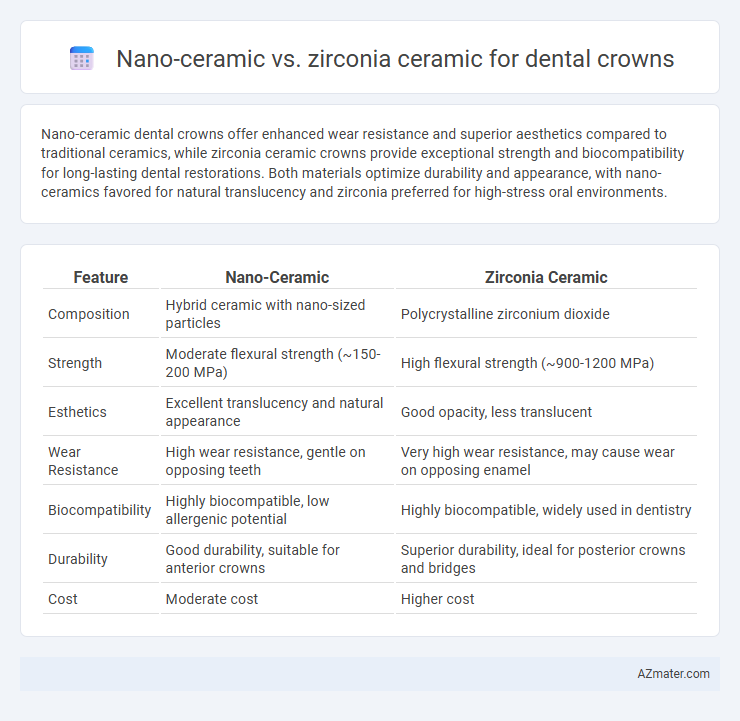Nano-ceramic dental crowns offer enhanced wear resistance and superior aesthetics compared to traditional ceramics, while zirconia ceramic crowns provide exceptional strength and biocompatibility for long-lasting dental restorations. Both materials optimize durability and appearance, with nano-ceramics favored for natural translucency and zirconia preferred for high-stress oral environments.
Table of Comparison
| Feature | Nano-Ceramic | Zirconia Ceramic |
|---|---|---|
| Composition | Hybrid ceramic with nano-sized particles | Polycrystalline zirconium dioxide |
| Strength | Moderate flexural strength (~150-200 MPa) | High flexural strength (~900-1200 MPa) |
| Esthetics | Excellent translucency and natural appearance | Good opacity, less translucent |
| Wear Resistance | High wear resistance, gentle on opposing teeth | Very high wear resistance, may cause wear on opposing enamel |
| Biocompatibility | Highly biocompatible, low allergenic potential | Highly biocompatible, widely used in dentistry |
| Durability | Good durability, suitable for anterior crowns | Superior durability, ideal for posterior crowns and bridges |
| Cost | Moderate cost | Higher cost |
Introduction to Dental Crown Materials
Nano-ceramic dental crowns offer enhanced esthetics and improved wear resistance due to their finely structured ceramic particles, providing a natural tooth-like appearance. Zirconia ceramic crowns are known for exceptional strength and durability, making them ideal for posterior teeth requiring high load-bearing capacity. Both materials have distinct properties that influence their selection based on clinical needs, with nano-ceramics prioritizing esthetics and zirconia emphasizing longevity and mechanical performance.
What is Nano-Ceramic?
Nano-ceramic dental crowns consist of ultra-fine ceramic particles combined with resin to enhance strength, durability, and esthetics, offering improved wear resistance and a natural appearance. These crowns provide excellent translucency and polishability, closely mimicking the optical properties of natural teeth. Compared to zirconia ceramic, nano-ceramics have superior shock absorption but may be less resistant to extreme biting forces.
What is Zirconia Ceramic?
Zirconia ceramic, composed primarily of zirconium dioxide, is renowned for its exceptional strength, biocompatibility, and natural tooth-like appearance, making it a popular choice for dental crowns. Its high fracture toughness and resistance to wear outperform many other ceramic materials, including nano-ceramic alternatives. Zirconia crowns provide durability and esthetic appeal, especially suitable for patients needing long-lasting restorations in both anterior and posterior teeth.
Strength and Durability: Nano-Ceramic vs Zirconia Ceramic
Nano-ceramic dental crowns offer enhanced flexibility and resistance to chipping due to their composite resin matrix, making them less prone to fractures under moderate bite forces. Zirconia ceramic crowns exhibit superior strength and toughness, with fracture resistance values often exceeding 1000 MPa, which ensures long-term durability even under heavy occlusal stress. The high flexural strength and fracture toughness of zirconia make it the preferred choice for posterior crowns where maximum strength and wear resistance are critical.
Aesthetics and Natural Appearance
Nano-ceramic dental crowns offer superior translucency and color-matching capabilities, closely imitating the natural enamel's luster and shade gradation. Zirconia ceramic crowns provide high strength with a slightly less translucent finish, often requiring layering to achieve natural aesthetics. Both materials enhance smile appearance, but nano-ceramics excel in mimicking the subtle optical properties of natural teeth.
Biocompatibility and Patient Safety
Zirconia ceramic dental crowns exhibit superior biocompatibility due to their inert nature, minimizing allergic reactions and tissue irritation, making them highly suitable for patients with metal sensitivities. Nano-ceramic crowns, while offering enhanced aesthetics and wear resistance, may present slightly higher risks of marginal inflammation due to their composite matrix. Both materials are FDA-approved, but zirconia's proven long-term stability and low plaque affinity enhance patient safety in restorative dentistry.
Tooth Preparation and Fit
Nano-ceramic dental crowns require minimal tooth reduction due to their superior strength and flexibility, preserving more natural tooth structure compared to zirconia crowns. Zirconia ceramic demands more extensive tooth preparation because of its thickness requirements to achieve optimal strength and durability. The fit of nano-ceramic crowns often results in better marginal adaptation and reduced risk of microleakage, while zirconia crowns provide a highly precise fit but may require additional adjustments during placement.
Longevity and Wear Resistance
Nano-ceramic dental crowns offer enhanced longevity due to their superior crack resistance and fracture toughness, making them highly durable in daily oral activities. Zirconia ceramic crowns exhibit exceptional wear resistance, maintaining structural integrity against abrasive forces and resisting chipping even under high occlusal stress. Both materials provide long-term performance, but zirconia's hardness generally surpasses nano-ceramics in resisting surface degradation over extended periods.
Cost Comparison: Nano-Ceramic vs Zirconia
Nano-ceramic dental crowns typically offer a more affordable option compared to zirconia crowns, with costs generally ranging between $800 and $1,200 per crown, while zirconia crowns can cost from $1,000 to $2,500 due to their superior durability and esthetics. The price difference is influenced by material properties; zirconia's high strength and longevity justify the higher expense, making it a cost-effective choice over time despite the initial investment. Patients seeking budget-friendly solutions may prefer nano-ceramic crowns, but those prioritizing long-term wear resistance and minimal maintenance often find zirconia crowns more economically viable in the long run.
Choosing the Right Material for Your Dental Crown
Nano-ceramic dental crowns offer exceptional esthetics and natural translucency, closely mimicking the appearance of natural teeth, while zirconia ceramic crowns provide superior strength and durability, making them ideal for molars and areas with high bite pressure. Choosing the right material depends on factors such as the crown's location, patient's bite force, and aesthetic preferences, with nano-ceramics favored for front teeth and zirconia for posterior restorations. Understanding these material properties ensures optimal longevity and appearance of dental crowns tailored to individual patient needs.

Infographic: Nano-ceramic vs Zirconia ceramic for Dental crown
 azmater.com
azmater.com